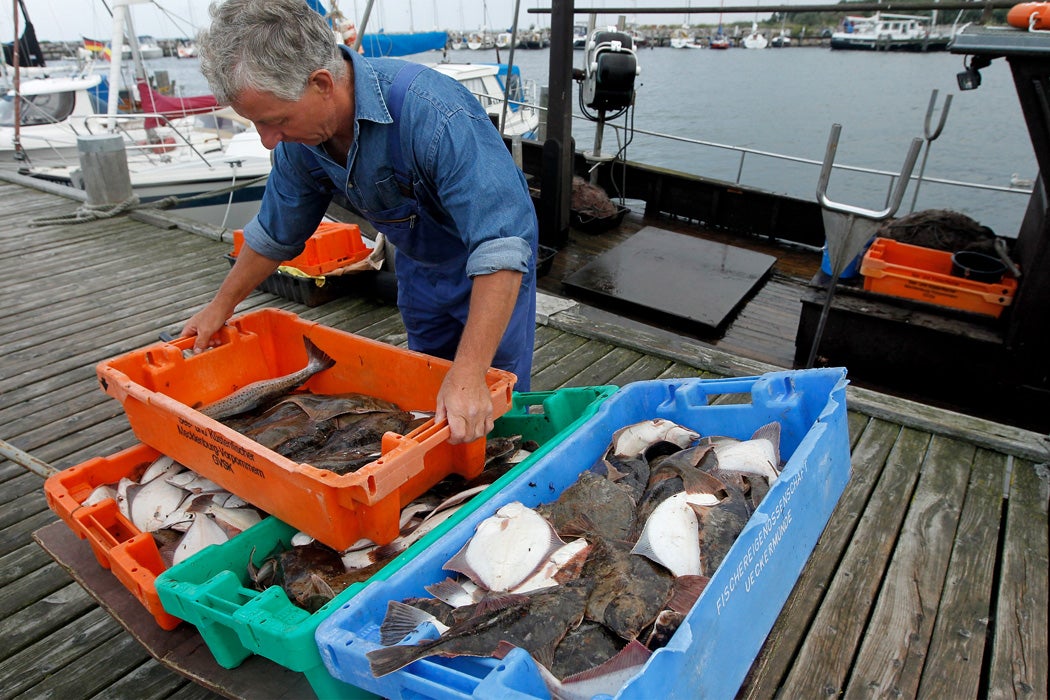Welcome to JSTOR Daily’s Planet-Conscious Weekly Summer Travel Series! From electric cruise ships to high-speed trains, we will investigate better, more sustainable ways to travel and interact with the world.
American demand for seafood is reaching record levels. In 2017, American fishermen landed 9.9 billion pounds of fish and shellfish—a 344 million pounds or 3.6 percent increase from the year before. The country imported 5.9 billion pounds of shrimp, salmon, and tuna, among other ocean bounty products. Seafood is healthy, nutritious, and delicious, but exactly how sustainable is our growing appetite for it? The answer is far from simple.
In the days before factory-size trawlers outfitted with freezers began to process their catch at sea, fresh fish was primarily available to those living near the coast. Other seafood connoisseurs enjoyed their fish in dried, smoked, or pickled form. Refrigeration was a game-changer for fishermen who were able to transport their catch across long distances, reach faraway markets, and store it frozen for sale during the off-season. That seemingly positive business development resulted in unintended environmental consequences. Today, seafood caught by large commercial producers in the United States travels on average more than 5,000 miles before landing on consumers’ plate—with use of fossil fuels. Seafood caught in the United States and shipped to China for processing obviously travels even farther than that.
These technologies have also introduced competition from fish farmers and foreign fishermen, who now were also able to reach those same markets. As changes in world trade policies opened United States markets to farm-raised seafood from Asian and South American producers, the new competition brought down prices, dramatically changing the seafood business for the American fishermen. At the same time, fish stocks began to decline, resulting in meager catches, more stringent regulations, and other restrictions, which affected the livelihood of small-scale family fishermen. According to the North Carolina Division of Marine Fisheries, between 1981 and 2005, the amount of catch declined from 432 million pounds to 79 million pounds. And between 2000 and 2005, the value of that catch dropped from $108 million to $64 million.
Today, fisheries are among the most regulated resources in the United States, and yet biologists and other experts are warning about possible global fisheries collapse by 2048, dramatically affecting those who catch fish and those who eat it. Governing fisheries internationally, which involves cooperation between different countries, is harder—some fisheries have already collapsed. To prevent this, the Worldwatch Institute recommends that we support small-scale fishing methods, eat species that haven’t been overfished, and reduce how far our seafood travels.
Not surprisingly, the easiest way to fulfill that requirement is to eat your local catch. And buying fish locally is now easier too.
While fishermen have been landing more fish in recent decades, it doesn’t mean the catch is sustaining them. Frustrated with plummeting prices, foreign competition and other hurdles, many American fishermen are now marketing their catch directly to consumers, including local restaurants and individuals. Inspired by the success of the community supported agriculture, fishermen began to form community-supported fisheries or CSFs over a decade ago. The approach caught on—between 2007 and 2015, the number of CSFs grew to about 250, nearly doubling since then.
Weekly Newsletter
CSFs’ benefits are three-fold. The fishermen eliminate middlemen, raising the value of their catch—one North Carolina CSF let fishermen increase their monthly revenue by 33 percent and even more by year-end. Consumers receive fresh fish, which is sustainably caught because small-scale fishermen tend to use less destructive equipment than industrial fleets—for example hook and line gear that doesn’t produce loads of by-catch like trawler nets. Lastly, the environment footprint of transportation is much smaller. On average seafood sold through CSFs travels only sixty-five kilometers.
So if you want to eat your fish sustainably, ask for the local catch. The fish you would get would likely have been still swimming hours ago. Seafood doesn’t get fresher than that. It’s more sustainable for the environment, and for the fishermen themselves.







